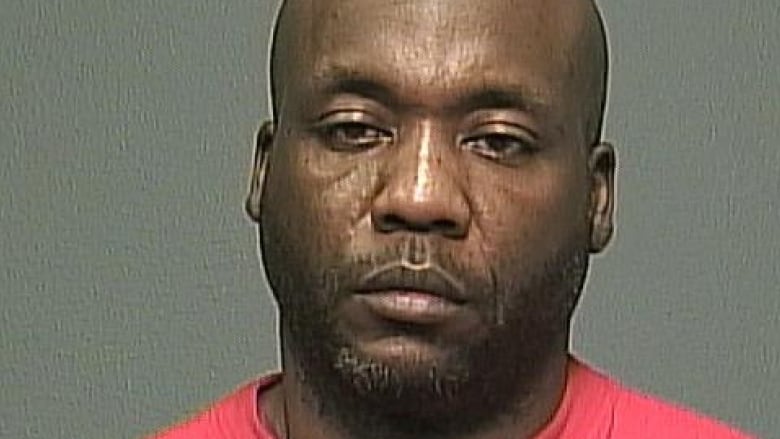Man pleads not guilty to murdering woman found decomposing in barrel in 2016
Judge rules DNA linking Jennifer Barrett to blood stains will be heard at trial, against defence's wishes

The man accused of murdering a woman and leaving her for months to decayin a barrelis pleading not guilty, but his lawyers didn't get their waywhen a judge ruled a piece of DNA evidence the Crown argues is "critical" to the case should go before a juryrather than be excluded at trial.
PerezAdaryllCleveland, 43, appearedin a Winnipeg courtroom Tuesday, where he pleadednot guilty tofirst-degree murderin the 2016 death of Jennifer Barrett.
Barrett, 42, was found decomposing in a barrel in the backyard of aWaverleyHeights home onDec. 1, 2016. Police said her body was found in chemicals meant to aid in decomposition andestimate she was killed on or around Aug. 25, 2016.
A warrant was issued in September of that year and Cleveland was arrested Dec. 13, 2016. He was charged with 55 offences, including assault with a weapon, uttering threats and parole violations.
Cleveland's defencelawyers, Jeremy Kostiuk and SaheelZaman, filed a motion to block DNA evidence linking Barrett to blood stains in the basement of the home wherewitnesses say she was beaten before her body was hidden.
Manitoba Court of Queen's Bench Justice GlennJoyaldenied the motion and ordered theevidence beconsidered by a jury at Cleveland's upcoming trial,which is expected to take place next year.

Barrettand Cleveland met and dated in Sudbury, Ont., but broke up in the 1990s, her brother Jason Barrett told CBC News in March.
In 1999, Sudbury police issued an arrest warrant for Cleveland for a series of offences, including assault and threatening death.
Jason saidCleveland and his sister, a nurse and mother, connected again and she moved from Sudbury in 2012, eventually landingin Winnipeg.
Police believe Cleveland assaulted Barrett over the course of several days and then killed her more than three months before her body was found.
Blood of 'marginal' significance: defence
Using DNA samplesfrom Barrett's parents, Crown attorneys Christian Vanderhooftand Breta Passlersaid police were able to identify her body and confirm the presence of her blood in the basement.
Court heard the Crown intends to call at least two witnesses during trial who previously told police Cleveland beat Barrett in the basement and that's where the blood came from.
Kostiukdoesn't accept a beating took place in the basement. The defence lawyer saiddetails from witnesses about what allegedly happened differ.
I'm not sure what would qualify as a moremeaningful and supportive bit of corroborative information but for perhaps a video camera recording the darn incident.- Justice Glenn Joyal
Apart from what witnesses told police, Kostiukargued there wasno concrete proof thatCleveland assaulted Barrett, and that jury members could wrongly make a leap and infer the forensicevidence does indeed tie Cleveland to the bloody basement scene.
"I'm not saying that it isn't relevant," Kostiuk said.
"The extent towhich the blood stain helps them, it's not zero, but it's far from the end all and be all.Andthe risk is the aura of scientific respectability, that thejurymight wrongly use that incorrectly on an intellectual level to prefer a version of events that the Crown wants to advance rather than the accused."
For those reasons Kostiuk said the blood stains were of "marginal" significance andasked JusticeJoyalto not allow the evidence to beconsidered by a jury.
Joyalrejected the defence request.
"When you say that this is a marginal bit ofsubstantiation or corroboration, I'm not sure what would qualify as a moremeaningful and supportive bit of corroborative information, but for the timing and but for perhaps a video camera recording the darn incident," Joyalresponded to Kostiuk.
'Pretty direct evidence'
Justice Joyalwent on to say the Crown's case against Cleveland will bebased on witness testimony and "significantly circumstantial" evidence, but Vanderhooft disagreed with that characterization.
"When two witnesses say, 'Perez Cleveland killed this person in the basement, asked us to clean up the body, asked us to assist in resuscitating her, took the body to the garage and theoutside of the house and left it there, and we were told what to do, to clean it up,' I'd say that's pretty direct evidence," Vanderhooftsaid.
Jessica Elizabeth Reid, who was 34 at the time ofBarrett's death, and HolleyAlyssaSullivan, then 28, lived in the home where Barrett was found.
Theywere charged with accessory to murder after the fact in connection with her death. Police believe Reid and Sullivan were involved in some way.
In 2016, about two months after police believe Barrett was killed, Reid took out a restraining order on Cleveland, her former partner.
The group moved out of the home in November of that year.
In addition to tying Cleveland to the murder, Vanderhooft said the blood in the basement also establishes that Barrett, Cleveland and the witnesses were all living in the home together, and that belongings of Barrett's found in the basement weren't there by accident in the days leading up to her disappearance and death.
"Obviously Ms. Barrett didn'tclimb into a barrel and end up in the backyard of this residence," Vanderhooft said.
"[Cleveland] left shortly after she went missing. Now, that circumstance the facthe left the residence and went to move and live somewhere else and her blood was found thereis very important."
Cleveland's trial is expected to take place in May and June of 2019.












_(720p).jpg)


 OFFICIAL HD MUSIC VIDEO.jpg)
.jpg)



























































































